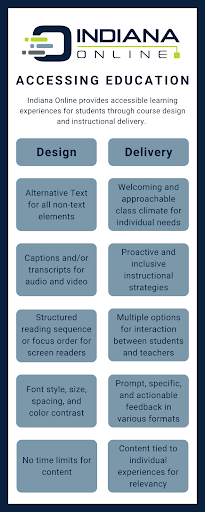
In education, accessibility is an approach that enables each student to have the same opportunities to access information and engage in learning. Students whose abilities hinder their capacity to examine content or engage in learning through visual, auditory, or physical manipulation are at a disadvantage unless accessible features are in place. Accessibility is especially critical in the online learning environment. One way that Indiana Online incorporates accessibility into our courses is through Universal Design for Learning (UDL). The principle behind Universal Design is to build accessible features into products (such as online learning), so that those features are available to everyone without adaptation or specialization. According to the American Institutes for Research, “UDL is designed to serve all learners, regardless of ability, disability, age, gender, or cultural and linguistic background. UDL provides a blueprint for designing goals, methods, materials, and assessments to reach all students including those with diverse needs.” To put it into perspective, one example of Universal Design outside of the learning environment is ramps to access buildings. While not everyone needs a ramp to access a building, the ramp is available for those who do need it; meanwhile, those who don’t need the ramp can still benefit from its presence. The same is true for the learning environment. Screen readers are one type of assistive technology used to read text aloud to learners. Many students with visual impairments rely on such technology. However, screen readers benefit other students, too: auditory learners, students with focus and attention deficits, English language learners, and students with low processing abilities. At Indiana Online, accessibility plays a role in all aspects of instructional delivery including course design and teaching practices.
Course design requires that all instructional materials, activities, and assessments be designed not only in alignment with learning objectives, but also with the needs of each learner in mind. In fact, course design must be accessible by law. Sections 504 and 508 of the Vocational Rehabilitation Act and the Individuals with Disabilities Education Act (IDEA) mandate design accessibility. While the legality of accessibility is certainly important to us, what truly drives the designers at Indiana Online is our background in education and our desire to provide learning opportunities that benefit all students. Indiana Online Instructional Designer, Dr. Taunya Kline, said it perfectly, “Accessibility is an area I have grown in dramatically and the more I learn, the more my design thinking changes for the better. When accessibility is an essential component in design and development, it gives us the opportunity to not only level the playing field for our students, but celebrates the diversity that is among us all.” To provide accessible learning experiences for our students, Indiana Online courses are designed with National Standards for Quality Online Courses, Quality Matters, and WCAG 2.0 standards in mind. These guidelines provide a set of design standards to ensure accessibility for all learners. Some notable features include: captions for audio content, minimal color contrast ratios, alternate text for images, and guidelines for font size, style and spacing. These features help support all learners. Like the examples given previously of accessible ramps and screen readers, these features provide opportunities for students with disabilities to access information and engage in activities, but they also support all learners. For example, visual learners benefit from captions for audio content because they can see the text in addition to hearing it. Likewise, students who view content on smaller screens such as tablets or mobile devices benefit from color contrast ratios and font size, style and spacing guidelines. Course design is only one aspect of Indiana Online’s pursuit to provide accessibility for our learners.
Teaching practices that meet Universal Design for Learning guidelines also provide accessibility for all learners, and the National Standards for Quality Online Teaching encourages UDL instructional practice through community building, engagement, diverse instruction, and assessment. At Indiana Online, we employ a wrap-around approach to ensure we are supporting the needs of our students in each of these areas. Our Student Services team conducts student orientations giving learners time to familiarize themselves with our specific technology platforms, similar to exploring a physical learning space, and the onboarding site provides resources for students and parents to successfully navigate the online learning environment. Teachers receive regular professional development focused on high-quality instruction for all students. Positive and inclusive learning environments are established by Indiana Online teachers contacting each student at the start of every course and frequent teacher communication in various formats which gives students multiple avenues to consume information. Indiana Online Social Studies teacher, Scott Cooper, states, “Instruction for online students needs to be not only relevant, but also contain different methodologies of instruction to maintain interest. Students relate to the subject by making connections between something they have and something in the past.” Multiple instructional methods are used to ensure accessibility and usability for all students, while cognitive supports such as graphic organizers, collaborative learning opportunities, and summarization help scaffold instruction to meet individual learning needs. Combining instructional strategies with high-quality, accessible course design allows Indiana Online to provide engaging learning experiences for all students.


